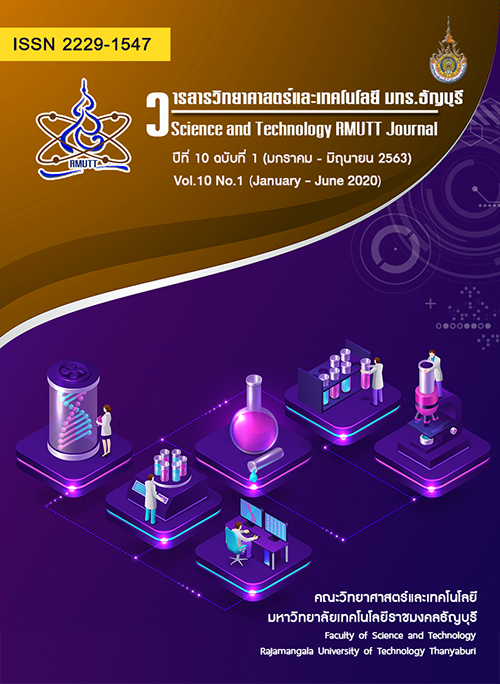Production of Bagasse Paper with Antibacterial Activity against Foot-Odor Causing Bacteria
Main Article Content
Abstract
The aim of this study was to evaluate the antibacterial activities of titanium dioxide (TiO2) and silver nitrate (AgNO3) against 3 foot-odor causing bacteria, including Bacillus subtilis, Staphylococcus aureus and Staphylococcus epidermidis. Broth microdilution assay revealed that the highest concentration (25mM) of TiO2 was unable to inhibit all tested bacteria while the minimum inhibitory concentration (MIC) of AgNO3 against B. subtilis, S. aureus and S. epidermidis were 0.3906, 0.7813 and 0.7813 mM, respectively and the minimum bactericidal concentration (MBC) of AgNO3 were 0.3906, 0.7813 and 0.7813 mM, respectively. When AgNO3 was coated on handmade bagasse paper, the antibacterial activity of the coated paper against B. subtilis and S. epidermidis was not different from that of the uncoated paper.
Article Details
References
Fernandez-Crehuet P. and Ruiz-Villaverde R. Pitted keratolysis: an infective cause of foot odour. CMAJ. 2015. 187(7) : 519.
Yamuna V. and Sudha S. Antimicrobial activity of fabrics treated with Quercus infectoria extract for foot odour control. BTAIJ. 2013. 7(6) : 231-235.
Sharquie K.E., Noaimi A.A. and Hameed S.D. Topical 15% Zinc sulfate solution is an effective therapy for feet odor. JCDSA. 2013. 3 : 203-208.
Ara K., Hama M., Akiba S., Koike K., Okisaka K., Hagura T., Kamiya T. and Tomita F. Foot odor due to microbial metabolism and its control. Can J Microbiol. 2006. 52(4) : 357-364.
ชลดา ธีรการุณวงศ์. ปฏิกิริยาการเร่งด้วยแสงโดยไทเทเนียมไดออกไซด์. วารสารมหาวิทยาลัยราชภัฏยะลา. 2554. 6(1) : 62-73.
Han C., Lalley J., Namboodiri, D., Cromer, K. and Nadagouda M.N. Titanium dioxide-based antibacterial surfaces for water treatment. Curr Opin Chem Eng. 2013. 11 : 46-51.
สนอง เอกสิทธิ์. งานวิจัยขึ้นห้าง: การสังเคราะห์อนุภาคซิลเวอร์นาโนแบบควบคุมสัณฐานวิทยา การจัดการความรู้เพื่อแปรรูปผลงานวิจัยพื้นฐานให้เป็นผลิตภัณฑ์นวัตกรรมทำกำไร. วารสารสถาบันวิทยาศาตร์และเทคโนโลยีขั้นสูง. 2558. 1(1) : 1-16.
ณปภา เอี่ยมจิรกุล, ปิยะนารถ เอกวรพจน์ และฐิติวัลคุ์ พูลนวม. อนุภาคนาโนเงินในงานทันตกรรม.วิทยาสารทันตแพทยศาสตร์ มหาวิทยาลัยศรีนครินทรวิโรฒ. 2556. 6(1) : 77-86.
Kubacka A., Diez, M.S., Rojo D., Bargiela R., Ciordia S., Zapico I., Albar J.P., Barbas C. Martins dos Santos V.A.P., Fernández-García M. and Ferrer M. Understanding the antimicrobial mechanism of TiO2-based nanocomposite films in a pathogenic bacterium. Sci Rep. 2014. 4 : 1-9.
Li L., Lee S., Lee H. L. and Youn H. J. Hydrogen peroxide bleaching of hardwood kraft pulp with adsorbed birch xylan and its effect on paper properties. Bioresources. 2011. 6(1) : 721-736.
Hu H. and Zhang H. Substitution of sodium hydroxide with magnesium hydroxide as an alkali source in the peroxide bleaching of softwood TMP. Cellulose Chem Technol. 43(7-8) : 325-330.
Harun S. and Geok S.K. Effect of sodium hydroxide pretreatment on rice straw composition. Indian J Sci Technol. 2016. 9(21) : 1-9.
Morones JR, Elechiguerra JL, Camacho A, Holt K, Kouri JB, Ramírez JT, Yacaman MJ. The bactericidal effect of silver nanoparticles. Nanotechnology. 2005. 16(10) : 2346-53.






